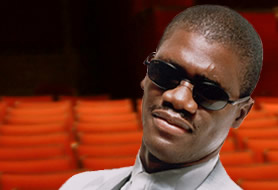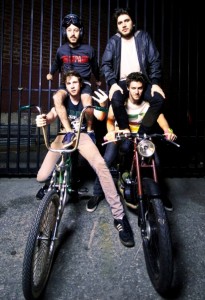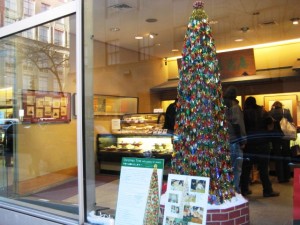Justin’s Japan: Interview with Jazz Pianist Marcus Roberts
By JQ magazine’s Justin Tedaldi (CIR Kobe-shi, 2001-02) for Examiner.com. Visit his NY Japanese Culture page here to subscribe for free alerts on newly published stories.
Blind since the age of four, at 21 years old Marcus Roberts was invited by trumpeter Wynton Marsalis to join his band in the mid-’80s, playing on such Grammy Award-winning albums as J Mood and Marsalis Standard Time, Vol. 1. Six years of touring with Marsalis followed, establishing Roberts as one of the vanguards of young American jazz pianists. Roberts formed his own trio in 1993, and since then he’s been indefatigably presenting his interpretive style around the world as a musician, recording artist and assistant professor of jazz studies at Florida State University.
This week finds the Marcus Roberts Trio, with Rodney Jordan on bass and NEA Jazz Master/Wynton’s little brother Jason Marsalis on drums, in a weeklong residency at New York’s Jazz at Lincoln Center. I spoke with Roberts about his discovery of jazz, the role of technology in his life as a musician, and his thoughts on working with legends like Marsalis and Seiji Ozawa.
What can fans expect from your upcoming shows in New York?
They can expect sort of a wide range of what we like to choose from our repertoire—we have a pretty broad repertoire. We play standard tunes of [George] Gershwin and Cole Porter; we play blues by [Thelonious] Monk and [Duke] Ellington; we play [John] Coltrane’s music; we have a lot of original music that we play; and Jelly Roll Morton. It’s going to be a little bit freer this week, you know. We’re just going to look through the book and pick kind of a historical tour of jazz, if you will.
What was your introduction to jazz?
I grew up in Jacksonville, Florida, and I first started playing piano in church. I was self taught for four years, from eight to 12, and then at 12 I was listening to the radio and I happened to hear Duke Ellington. And I just remember being really enamored with his touch; his style; the chords he was playing. And it went from there; I went from Duke to Louis Armstrong and then I ventured to Miles Davis and Coltrane and Monk, and one by one as the years went on, I got more deep in being interested in how these guys were playing all this stuff that they were coming up with, and how I could emulate that.
Who was your first love in music?
Probably Duke Ellington; I think my real first interest was him. And also [jazz pianists] Teddy Wilson and Mary Lou Williams—I remember hearing Mary Lou Williams with Benny Goodman, and that always struck me. I guess when I’m listening to a great jazz artist, what I’m really always looking for is something that can be taken even outside of the context that they put it in, and I’m able to personalize it and identify my own personality and identity within it. So, honestly, there are many great artists that I love.
Growing up, how did you come to learn about Japan?
I don’t know—I think the first time I went to Japan was with Wynton in 1987, and then I believe went again with a quartet in ’89. But my most memorable experiences of going to Japan have always been with the great conductor Seiji Ozawa. He invited me there a couple of times, and we’ve done Gershwin’s Concerto in F there a few times. It’s probably one of the highlights of my career, going there, doing that with him, because he’s such an innovator, such a great man, and he’s always been very interested in the relationship between how jazz and classical music can be collaborated together, and we always enjoyed working with him there in Japan.
What was it like performing with the maestro?
Oh, my God, absolutely incredible—he is just amazing. He knows that score inside and out, and his dedication to just greatness in general, he’s very infectious. And my band and the other musicians always knew that it was going to be a great performance, because he just wasn’t going to have it any other way. If he had the schedule for rehearsals, I’d talk to him, and by the time we got going, he’d been up since four o’clock in the morning studying scores, making sure that everything was going to be all right. So, he taught me a lot about how you put things on the stage and how you continue to push yourself to reach a real level of expertise and communication with an audience.
Do you enjoy traveling? Where are some of your favorite places around the world?
I enjoy traveling; it’s always fun. It’s always a blessing to be able to play to people and hopefully inspire them through the music you play to have a better day or just something they might be going through. For me, I pretty much will go anywhere, but I love Italy because of the food there, you know? I like going to New Orleans because of the food—I like a lot of places, but I can’t single out a whole bunch of them. I think it’s more about just the variety of the different cultures and the places you can go, because all those different localities have different things that they bring to you, and I guess, from my perspective, since every year we’re going to different places, I guess I’m more intrigued with the act of traveling itself, wherever it is. I also like France for the desserts, and Japan for the sushi. [Laughs]
Click here for the rest of the interview.
Justin’s Japan: All-time Anime Classic ‘Dragon Ball Z’ Comes to Hulu
By JQ magazine’s Justin Tedaldi (CIR Kobe-shi, 2001-02) for Examiner.com. Visit his NY Japanese Culture page here to subscribe for free alerts on newly published stories.
U.S.-based FUNimation Entertainment and Toei Animation Co., Ltd. have teamed up to present Japan’s evergreen animated series Dragon Ball Z at Hulu.com, North America’s online leader for streaming TV shows and film in North America.
Yesterday (Jan. 15), FUNimation began streaming the series’ first 15 episodes via Hulu, the official Dragon Ball Z website (www.dragonballz.com) in addition to www.dragonballzkai.com, www.funimation.com.
FUNimation will offer its professionally-produced, uncut, English-tracked and English-subtitled adaptations of the massively successful series beginning with the first episode as well as other chapters of the Dragon Ball franchise: Dragon Ball, Dragon Ball GT and Dragon Ball Z Kai.
Click here for the rest of the story.
Justin’s Japan: Anamanaguchi, Peelander-Z, Starscream to Rock NYC
By JQ magazine’s Justin Tedaldi (CIR Kobe-shi, 2001-02) for Examiner.com. Visit his NY Japanese Culture page here to subscribe for free alerts on newly published stories.
If you’re looking for new music from New York bands to kick off the new year, your search ends here. This Friday (Jan. 14), The Studio at Webster Hall will host a concert headlined by Anamanaguchi with support by Peelander-Z and Starscream.
If Anamanaguchi’s name is unfamiliar, their sound will whisk you back to the 1980s glory days of the Nintendo Entertainment System. As perhaps the biggest artists of the chiptune genre, the Brooklyn-based foursome tosses punk-flavored electric guitar, bass and drums on top of pop bloops and beeps from a hacked NES and Game Boy that yields retro-futuristic results on disc and onstage. Last year, the group composed the songs for the video game soundtrack based on the film Scott Pilgrim vs. the World, and in November they held a free concert in Union Square to support the controversial alcoholic energy drink Four Loko.
Click here for the rest of the article.
Justin’s Japan: Interview with NEA Jazz Master Hubert Laws
By JQ magazine’s Justin Tedaldi (CIR Kobe-shi, 2001-02) for Examiner.com. Visit his NY Japanese Culture page here to subscribe for free alerts on newly published stories.
With a career in music that began in the 1960s, Grammy-nominated flautist Hubert Laws’ latest honor is the NEA Jazz Master Award, which since 1982 is the highest prize the U.S. bestows upon living jazz musicians.
Laws will appear at a free panel discussion with the other 2011 NEA Jazz Masters at New York’s Jazz at Lincoln Center on Jan. 10. (Doors open at 12:45 p.m., and a live video stream can be seen here.) The following night, he will perform at the annual NEA Jazz Masters Awards Ceremony and Concert. For those who can’t attend the sold out show, there will be a live video stream on the NEA website along with a simulcast on the Newark-based WBGO Jazz 88.3 FM and their site, and Sirius/XM Satellite Radio’s Real Jazz Channel 70.
This year also marks the artist’s 40th anniversary of his first trip to Japan. I spoke with him about his time there along with some of his other personal highlights as a musician.
Congratulations on your NEA Jazz Master award. How does it feel to receive this honor?
After learning of its significance, it is a humbling experience to be named among other respected artists of special accomplishment.
How did you find out that you won his award? Did you or anyone else campaign for it?
I happened to be on a tennis court playing doubles when my cell phone rang during a changeover. The gentleman asked if I had a moment—I said, “About 90 seconds.” When he announced the award, I said, “I think my partners will wait a little while longer.” I was not aware of this award, so could not “campaign” for it.
Tell us about your history playing in Japan and working with Japanese artists as a musician.
My first tour in Japan began in Tokyo in 1971 with the “CTI All-Stars” [Freddie Hubbard, Stanley Turrentine, George Benson, Grover Washington, Ron Carter, Bob James, Ester Philips, Hank Crawford and others].
We were greeted at Narita Airport by fans with banners and fanfare as though we were rock stars. That tour included several cities for about two weeks. Since then, 15 other trips there included my own group at the Blue Note Club, another with Ron Carter and his group, Chick Corea and his group, and Sonny Rollins with the Yomiuri Symphony Orchestra, where I premiered the Concertino for Flute and Orchestra by Harold Blanchard. This performance can be seen on the 30 Year Retrospective DVD; and excerpts can be seen on my website. The Laws family [Ronnie, Debra, Eloise and Hubert] appeared at the Cotton Club there in 2007. A JVC Jazz Festival was held there. where Eloise and I appeared there along with Nancy Wilson and others.
My most recent CD features Japanese child prodigy and pianist/keyboardist Yayoi Yoshida in flute adaptations of classical compositions: Rachmaninov’s Piano Concerto #2 and Samuel Barbers’ Adagio for Strings. Excerpts also can be heard on my site.
Why do you think the Japanese enjoy jazz so much?
As a culture, it appears that the Japanese gravitate heavily toward education. This value seemingly leads to appreciation of substance. There is great “substance” in the art of improvised music commonly known as “Jazz.” As in any culture, the “foreign mystique” may also play a part. “A prophet is not unhonored except in his home territory and in his own house.” –Matthew 13:57, New World Translation of Holy Bible.
Click here for the rest of the interview.
See some familiar JET faces (including that of JetWit founder Steven Horowitz) in the latest issue of Shukan NY Seikatsu, a free, weekly Japanese newspaper available in New York. Along with Steven, JET alums Stacy Smith, Kia Cheleen, Tamar Entis, and Paul Benson sat down with the paper to talk about their experiences for a special New Year’s issue. The even was organized by Jon Hills, founder of Hills Learning (and husband of JET alum Kendall Murano).
The group was asked about what they learned from Japan, what they loved about their areas, what they thought was cool about Japan, and what their reactions were to some of the criticisms Japanese teachers have of JETs. The resulting “NY Cool” feature is front page news, with the full length article inside.
Read the full issue online here (the JET profiles are on page 4 and 5):
http://viewer.nyseikatsu.com/viewer/index.html?editionID=331&directory=../editions&page=1
For more background on the write-up, see this previous JetWit post.
Happy reading!
-Gail Meadows
Associate Editor, JetWit
JET alum manga artist featured in New York Times
 Kudos to JET alum Zach Wood (ALT Niigata 2007-09), who was recently featured in a New York Times article about the increase in the number of Japanese universities offering degrees in manga and animation. Zach is a graduate of Stanford University in California and is studying manga at Kyoto Seika University, which established Japan’s first manga program. Universities offering these kind of programs say they are hoping to significantly increase the number of international students enrolled. See the article here:
Kudos to JET alum Zach Wood (ALT Niigata 2007-09), who was recently featured in a New York Times article about the increase in the number of Japanese universities offering degrees in manga and animation. Zach is a graduate of Stanford University in California and is studying manga at Kyoto Seika University, which established Japan’s first manga program. Universities offering these kind of programs say they are hoping to significantly increase the number of international students enrolled. See the article here:
Japanese Universities Draw Foreign Students With Manga
JET alum shares perspectives of Japan in Metropolis magazine
 JET alum Mark Flanigan (Nagasaki 2000-04) wrote to JetWit to share his writing “debut” in Tokyo, featured in Metropolis Magazine. Following his stint in Nagasaki, Mark returned to Japan as a Rotary International World Peace Fellow at International Christian University (ICU) / 国際基督教大学 in Tokyo. He says:
JET alum Mark Flanigan (Nagasaki 2000-04) wrote to JetWit to share his writing “debut” in Tokyo, featured in Metropolis Magazine. Following his stint in Nagasaki, Mark returned to Japan as a Rotary International World Peace Fellow at International Christian University (ICU) / 国際基督教大学 in Tokyo. He says:
I am very happy and also humbled to have been selected to write for such a great magazine. In my article, I talk about some of the different impressions I have found here, as a JET and now as a Peace Fellow, and compare/contrast my feelings of my two different times spent living in Japan.
Click here to read the article, “Found and Lost: Reflections on my two Japans.”
Justin’s Japan: Interview with NEA Jazz Master David Liebman

2011 NEA Jazz Master Dave Liebman. (Marek Lazarski, courtesy of the National Endowment for the Arts)
By JQ magazine’s Justin Tedaldi (CIR Kobe-shi, 2001-02) for Examiner.com. Visit his NY Japanese Culture page here to subscribe for free alerts on newly published stories.
Brooklyn-born saxophonist and flautist Dave Liebman is one of this year’s recipients of the NEA Jazz Master Award, which since 1982 is the highest honor the United States bestows upon living jazz musicians. Liebman is best known for his work with the legendary trumpeter Miles Davis, joining his band in 1973 for a 16-month stint and playing on two studio albums, the final ones that Davis would record for the rest of the decade, as well as several live bootleg concerts that are available.
Liebman will appear at a free panel discussion with the other 2011 NEA Jazz Mastersat New York’s Jazz at Lincoln Centeron Jan. 10. (Doors open at 12:45 p.m.)The following night, he will perform at the annual NEA Jazz Masters Awards Ceremony and Concert. For those who can’t attend the sold out show, therewill be a live broadcast on the Newark-based WBGO Jazz 88.3 FM and their website, and Sirius/XM Satellite Radio’s Real Jazz Channel 70. I spoke with the artist about his thoughts on winning this award, his history in Japan, and his intriguing relationship with Miles.
How is one picked to be an NEA Jazz Master?
This is a very good question, which I hope to find out at the ceremony [laughs]…I think past inductees are a part of it—I have no idea. I can’t wait to know, assuming they will tell me the process.
Did you have to campaign for it?
Absolutely not; this was a phone call that came out of nowhere. I think my boss at the Manhattan School of Music, Justin DiCioccio, said he recommended [me], but the truth is, if you go to the site right now, you can put yourself in…the public is free to nominate anybody on the website. So that’s all I know about the process. How it goes from there to deciding [the inductees], I don’t really know, and I’m curious to find out.
You’ve played with Japanese artists and appeared on their albums since the early ’70s. How did that come about, and what were your impressions from visiting Japan through the years?
Of course, I had a lot of action in the ’70s and into the ’80s, but not so much in the last 10 to 15 years. First of all, the Japanese audience at that time was fantastic, and of course Miles Davis was a gigantic hero. The fact that I was with Miles put me right away into a special arena, and sure enough as soon as I got there I recorded. When I was on my first tour with Miles in Japan—it was the only time I went with Miles to Japan—I recorded my first record as a leader [First Visit, with Jack DeJohnette, Richie Beirach and Dave Holland], because Stan Getz’s group was there and the rhythm section was ready to go. I recorded with Abbey Lincoln also that week. In those days, when you went to Japan somehow you ended up with record dates. They were very, very enthusiastic, and business was good.
And then I had, of course, a long-term relationship with Terumasa Hino, the trumpet player, and drummer Motohiko, his brother who passed away a few years ago. I worked many times with the Hinos in Japan at a lot of festivals. Most notably there were two big concerts that I did in the ’80s—one for John Coltrane with Wayne Shorter and then in the ’90s with Michael Brecker, again for Trane ten years later. But as I said, not so much in the last ten to fifteen years. It was fascinating how deep the Japanese audience got into the music and how enthusiastic they were. But it seems to have faded, from what I understand. This generation is not as interested as before. So I can’t speak about the present jazz situation there, but I certainly enjoyed my visits.
Why do you think the Japanese had such an interest and enthusiasm for jazz?
I don’t know. I think they were fascinated by anything American, first of all. They probably loved Dolly Parton, or Sting, or whomever. I think they really liked Western culture. They were fairly prosperous during that period and when prosperity comes, people have more time to do leisure activities, enjoy culture and arts and so forth.
I think the Japanese temperament in general, the arts of Japan—everything from the sword stuff to the tea ceremony to the kimonos to the shakuhachi—they’re a really high class, sophisticated culture; that’s part of their being. And jazz, being as sophisticated as it is appealed to them. I think that’s part of what made them like it more than other cultures in Asia for example. I don’t see China—although we don’t know yet—embracing it the way Japan did, just from the difference of their M.O., the way they are as people. Japan is culturally kind of like the equivalent in Europe of the Germans, who are also very musically sophisticated and are really the best audience to play for as far as educated goes.
When was the last you played in Japan?
I think 2004 or ’05, we did a festival in Kyoto celebrating the history of the city; it was a special festival and I played with my regular working group of the last twenty years. I think that was the last time. You know, in general they just really appreciate art.
Read the rest of the interview here.
Justin’s Japan: Interview with Video Games Live Icon Tommy Tallarico

See Tommy Tallarico with Video Games Live at the New Jersey Performing Arts Center in Newark Dec. 29 and 30. (Videogameslive.com)
By JQ magazine’s Justin Tedaldi (CIR Kobe-shi, 2001-02) for Examiner.com. Visit his NY Japanese Culture page here to subscribe for free alerts on newly published stories.
Tommy Tallarico is the co-founder and CEO of Video Games Live, a touring showcase that for over five years has combined the excitement of a rock concert with the power of a symphonic orchestra featuring the music of the some of the most memorable video games in history. As the show’s lead guitarist, Tallarico is also the producer of the Video Games Live: Level 2 Blu-ray and soundtrack album, which made history last October by landing on Billboard’s Classical Crossover chart and earning a Grammy nomination for the Civilization IV song “Baba Yetu,” the first video game song ever to be nominated. I spoke with Tallarico prior to VGL’s upcoming shows this week at the New Jersey Performing Arts Center, which will feature special guest performances by legendary female Japanese composer Kinuyo Yamashita (Castlevania).
This year’s VGL tour played around the world to new countries and fans. What were the biggest similarities and differences that you noticed among the crowds and the overall reception you received?
Each country we go to is different. They love different games; they play their favorite different systems. For example, when you’re paying in Japan, World of Warcraft isn’t really popular over there, because there’s not a lot of PC gaming. But when you play in China, World of Wacraft is like the biggest thing ever of all time. [laughs] So, crowds react to different things, and it’s always my challenge to create a set list and find out what the local gamers love and are into. But when you go to places like China and Taiwan and, most specifically, Brazil, the folks down there go absolutely nuts. I mean, they lose their minds. They’re so passionate and so appreciative that something like this exists and would come to their countries. It really shows.
Were there any things that really surprised you when visiting and performing in these new countries?
When we played to over 100,000 people in Taipei in one show, and we showed up at the airport, there’s literally hundreds of people there with signs greeting us at the airport and everything. That was pretty surprising.
Tell us about VGL’s Japan debut at Tokyo International Hall last fall. Which of your idols were you most excited about meeting and working with?
I had worked with everybody before the show, but what was really special about that show was the Koji Kondo performance. Of course, Koji Kondo is the composer of Mario and Zelda. This was the very first time, believe it or not, that Koji Kondo actually performed live in Japan at a video game covert. I found that to be unbelievable, so that was very special. Having both of the women who composed the Castlevania music there on stage was also pretty special as well, but I’d have to say that providing Koji Kondo with his first ever live performance in his home country of Japan was unbelievable. He played a solo piano piece of Mario, and he went into Mario Galaxy as well. It was really incredible.
Each VGL concert is performed by a local orchestra and professional musicians. Besides special guest appearances, are there any twists depending on where you play, or do the musicians understand what you’re trying to express as easily in places like Portugal and Poland as they do in the U.S.?
I think it’s more age delineated as opposed to area. Any young person in the orchestra—and when I say young, I’m talking maybe 45 and under—any young person in the orchestra for the most part knows a lot of the material, is really happy, and they understand it; they know what’s going on. And then some of the older people in the orchestra—not all, but there’s a smaller percentage of people, no matter what country we go to—they’re a little apprehensive at first; they don’t quite understand [it], playing this music that they’ve never heard, yet thousands of young people are screaming and cheering and clapping like it’s the second coming of Elvis Presley or the Beatles or something. And so, they’re confused by the end of it: “What’s all this stuff? World of Warcraft? Sonic the Hedgehog? This isn’t Stravinsky!”
These are classically trained musicians, but once they see the reaction of the crowd and hear the music and how it is, you know, legitimate music, they have a greater understanding and appreciation for video game music. So, what starts out maybe for some of the older, traditional people as apprehension at the beginning of the day, turns into adoration by the end of it. I’ll get people coming up to me during the intermission, and they’ll say, “I’ve been playing the oboe for over 40 years, and I’ve never heard a crowd response like this. When are you guys coming back?” [laughs] So, it’s pretty cool to be able to give that to them.
As musical director, do you always do a full run-through with the orchestra prior to every night’s performance?
For sure. We also send the musicians the music months ahead of time.
When the show was performed in Brazil, it was subsidized by the government for getting young people involved in the arts. How did you arrange that, and what was the public’s reaction to that performance?
It was something that the promoters down in Brazil and myself worked on with the ministry of culture down there, and this is our fifth year back—it was our fifth year in a row down there. It’s something that I wish more governments could see the benefit of this, because we’re looking at tons of people and e-mails or people talking to us at the meet and greet, who all say things like, we brought our daughter to the show last night and we were all sitting around the breakfast table this morning and my daughter said, “Mom, I’d like to start taking violin lessons so I can learn the music to Zelda” or Kingdom Hearts or Final Fantasy or whatever, you know. So those are real stories, and, again, the Brazilian ministry of culture is fantastic to realize that and to say we want young people to be interested in the arts and culture, and what better way than to give them a presentation of something that they know and love and enjoy, and are passionate about. I wish other countries did that; I wish our country did that! [laughs]
Click here for the rest of the interview.
JetWit Writing Opportunities: 12/27/10
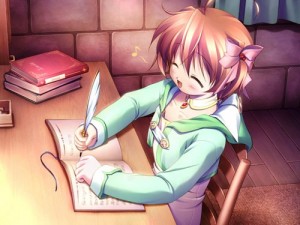 Starting in 2011, JetWit will be teaming up with JETAA New York’s JQ magazine to feature JET alum and Japan-related feature stories! Much like JQ’s Brainstorm Crew postings featuring story ideas, we would like to present the below JetWit Writing Opportunities for real-time instant story posting. This means no more waiting for the publication of seasonal issues! Below are story ideas grouped by JET participants and alumni (JET World) and those more on Japanese culture (Japan World). If you’re a JET or JetWit contributor, we welcome your interest or additional story ideas! Contact JQ editor Justin Tedaldi at justintedaldi [at] jetwit.com to sign up and for more info.
Starting in 2011, JetWit will be teaming up with JETAA New York’s JQ magazine to feature JET alum and Japan-related feature stories! Much like JQ’s Brainstorm Crew postings featuring story ideas, we would like to present the below JetWit Writing Opportunities for real-time instant story posting. This means no more waiting for the publication of seasonal issues! Below are story ideas grouped by JET participants and alumni (JET World) and those more on Japanese culture (Japan World). If you’re a JET or JetWit contributor, we welcome your interest or additional story ideas! Contact JQ editor Justin Tedaldi at justintedaldi [at] jetwit.com to sign up and for more info.
Also, we are now looking for a volunteer who’s skilled in graphic design to help us create a modified JetWit logo! Anyone who wants to get in touch on this can also do so at the e-mail above.
***JET WORLD***
JET ALUM IN UPCOMING DOCUMENTARY ON JAPANESE VIDEO ARCADES
Casey Novotny (Kochi-ken, CIR and Prefectural Advisor) now works at Asia University, and was interviewed as a talking head for the upcoming documentary film 100 Yen: The Japanese Arcade Experience. The film is currently in production, and Casey is happy to share his experiences of being contacted for this unique film for a feature story or interview.
JET ALUMS DEVELOP JAPANESE FLASH APP
Mark Makdad, founder of software company Long Weekend Mobile, has developed with his partner Ross Sharrott the Japanese Flash vocabulary builder app for iPhone, as well as the Rikai Browser for iPad for reading Japanese. Interested in giving these products a spin and writing about them?
JET ALUM MICHAEL JIM GANNON PROFILE
Jim Gannon (Ehime 1992-94) has been the executive director of the Japan Center for International Exchange (JCIE/USA) in New York since 2002. Headquartered in Tokyo, JCIE is one of the leading international affairs organizations in Japan. Jim was also the writer of the “JET Program on the Chopping Block” article published last summer. Talk to him about his work, Japan, and the continuing efforts to support JET in light of what’s happening in Tokyo.
PROFILE A SEATTLE-AREA JET ALUM
Kirsten Henning, Vice President of the Japanese Cultural & Community Center of Washington, is a senior project manager at Pyramid Communications and serves as an active volunteer for the Girl Scouts and Densho. Prior to joining Pyramid, Kirsten worked at the Seattle Mariners as media liaison and interpreter for Ichiro Suzuki and the Japanese press corps and then went on to manage media relations for Team Japan, champions of the inaugural World Baseball Classic. She spent the previous six years in Japan as a JET Program participant and later as special VIP liaison at Park Hyatt Tokyo. She holds a B.A. in East Asian Studies from Barnard College of Columbia University and also studied at the Stanford University Japan Center in Kyoto, Japan.
JET INSTANT NOODLE COMICS
Profile of JET alum artist Shun Endo and his “JET Instant Noodle Comics.” Read samples at http://jetwit.com/wordpress/2010/10/25/instant-noodle-comics-i-wish-facebook-had-the-boss-filter.
JET ALUM/SAKE EXPERT JOHN GAUNTNER
John Gauntner is a JET alum and noted lecturer on sake who travels the world to speak all about this appealing beverage. He has published a score of books on the topic and spoke at Japan Society last May. Visit his website www.sake-world.com.
ISSHONI LONDON – JET ALUM BLOG
London JET alum Vanessa Villalobos writes about Japan-related events, news, review and interviews. This would be a good Q&A piece for any JETs wanting to learn more about how our alumni groups operate overseas. Learn more at:
www.facebook.com/pages/Isshoni-London/119415767689
www.twitter.com/IsshoniVanessa
An innovative telecommunications site for Team Teaching, founded by a JET. www.teamteachers.com
JETSET – CANADIAN JETS IN JAPAN
Melissa C. runs JETset, a site for Canadian JETs in Japan and a well-known resource center for JET participants. See more for a profile at http://www.jetsetjapan.com.
***JAPAN WORLD***
WHERE DO YOU GET YOUR JAPAN FIX?
In an effort to revive the “Japan Fix” posts, we’d like to share a recent discoveries to help readers find a little piece of Japan close to home. How do you get your Japan fix wherever you live? Write it down and send it to Gail Cetnar Meadows (Hiroshima-shi, 2007-10), co-founder of Hiroshima JET webzine the Wide Island View, at gail [at] jetwit.com for the entertainment and benefit of the JET alum community.
ROBIN SAKAI OF GAIJIN POT
Gaijin Pot is a site that offers jobs, apartments and classifieds in Japan. Run by Robin Sakai, it strives to bring the Japanese and expat community together.
REVIEW OF JAPANESE LANGUAGE STUDY OPTIONS IN THE NY AREA
JetWit would like to add a listing as well as a possible review of Japanese language study options in the New York area. One of these is Hills Learning, founded by Jon Hills, who works with JETs in New York to promote his learning center, which teaches four languages to children and adults. Jon also co-presents monthly Asian networking events. Jon is open to a profile. Learn more at www.hillslearning.com.
RESTAURANT REVIEWS
JetWit is accepting reviews on any Japanese restaurant that you’d like to spread the word about. (Even better if they’re run by JETs.) JET alum Jamie Graves runs Kajitsu, an East Village restaurant in New York specializing in shojin cuisine, an ancient Japanese culinary practice developed in Zen Buddhist monasteries.
FILM/BOOK REVIEW
We are also accepting reviews or books and movies (past and present) related to Japan or the JET experience. Whether you’re checking out the theatrical release of a new anime film or digging into new translations of Natsume Soseki’s classics Kokoro and Sanshiro (coming this February), let us be your sounding board.
GOHAN SOCIETY OF NEW YORK
Profile. Based in New York, Gohan Society’s mission is to foster an understanding and appreciation of Japan’s culinary heritage in the United States through outreach to chefs, culinary arts professionals and all who admire and enjoy Japanese culture.
Gohan Society serves as a resource center for knowledge of traditional Japanese ingredients, techniques and food-related products, and as a catalyst for the expansion of that knowledge in the United States.
CONSULATE GENERAL SCHOOL CARAVAN
This is a decade-plus program run by New York’s Consulate General of Japan that sends consulate staff (American and Japanese) to New York high schools and junior high schools to introduce students to Japanese culture, and JET alums have even served as presenters! The purpose of this article will be to increase awareness of the program so more JETAA members can get involved.
KEIO ACADEMY OF NEW YORK
Based in Purchase, NY, Keio Academy is a school for bilingual and bicultural education established by its Tokyo namesake. Besides the various activities the school offers, it also seeks to recruit JET alums for potential work opportunities. We can put you in touch with their business officer, who is happy ro speak with more JETs about the subject.
ASIA SOCIETY OF NEW YORK
In Jan. 2010, NYC’s Asia Society held a concert called “Hogaku,” or Japanese folk instruments played with modern flair. We’ve never profiled Asia Society, so this would be a great time to find out more about how they select their Japanese attractions and exhibitions.
JAPAN INFORMATION CENTER OF NEW YORK
Profile. Take advantage of Japan Information Center to promote Japan!
The Japan Information Center (JIC) is the cultural and public affairs section of the Consulate General of Japan in New York. The JIC’s Services:
– Distributes educational materials, posters and pamphlets on Japan
– Provides speakers on various aspects of Japan to the schools throughout
this region
– Provides information on the Japanese Government Scholarships & the JET
Program
– Distributes the e-newsletter Japan Info
– Loans videos/DVDs and cultural artifacts
Please sign up to subscribe the Japan Info newsletter at www.ny.us.emb-japan.go.jp/en/c/ji_subscription.html.
For more information and to contact JIC, visit their website at www.ny.us.emb-japan.go.jp/en/b/01.html.
Justin’s Japan: An Origami Tree Grows in Rockefeller Center
By JQ magazine’s Justin Tedaldi (CIR Kobe-shi, 2001-02) for Examiner.com. Visit his NY Japanese Culture page here to subscribe for free alerts on newly published stories.
Minamoto Kitchoan, the Midtown Japanese wagashi (confectionery) shop with over 150 locations worldwide, is currently sporting a Christmas tree made up of 3,000 origami cranes, or orizuru.
According to store management, “The orizurus symbolize peace. They were made by kindergarten and elementary students in Japan and sent to New York as a tribute to the WTC Visitor Center.” This special Christmas tree was unveiled earlier this month at Minamoto Kitchoan’s Fifth Avenue store in the heart of Manhattan.
“We’ve decided to create an orizuru Christmas Tree in remembrance of tragic events of February 26, 1993 and September 11, 2001,” management explains. “Each orizuru comes with heartfelt hopes for peace.”
This sweet gesture is complemented by Minamoto Kitchoan’s own mission, which management says is to expand their business to every country in the world so that all can further experience and understand the beauty of Japanese culture through traditional Japanese wagashi, whether it’s Fukuwatshi Senbei (Japanese style vanilla cream filled cookie), the savory Benihana Ringo (apple cinnamon flavored bean jelly), or the delectable Kurizutsumi (red Bean paste and large piece of chestnut wrapped and baked in pie crust, topped with black sesame).
Click here to read the rest of the story.
Op-ed on natural gas development by JET alum
![]() JET alums continue to make their voices heard. Here’s a recent opinion article by New York-based alum Sam Lederer (Shizuoka-ken, 2005-07), a Contributor at Americans for Energy Leadership, on the importance of better regulation over natural gas exploration in the U.S.
JET alums continue to make their voices heard. Here’s a recent opinion article by New York-based alum Sam Lederer (Shizuoka-ken, 2005-07), a Contributor at Americans for Energy Leadership, on the importance of better regulation over natural gas exploration in the U.S.
CLICK HERE to read some of Sam’s other writings on Japanese energy and environmental policy.
Sam can be reached via his LinkedIn profile and can be followed via Twitter @samlederer
Justin’s Japan: Interview with ‘Fried Chicken and Sushi’ Cartoonist/JET Alum Khalid Birdsong: Part 2 of 2
By
JQ magazine’s Justin Tedaldi (CIR Kobe-shi, 2001-02) for Examiner.com. Visit his NY Japanese Culture page here to subscribe for free alerts on newly published stories.
For Fried Chicken and Sushi, was it a conscious decision to make the lead character black?
Of course, definitely. I’m obviously an African American, and I think that I was concerned because I thought, is anybody going to want to read about this black guy going to Japan? I felt like I wanted to be true to who I am, and there’s a certain kind of way of being able to comment on race, the way that we perceive and look at people. When you go to Japan, they don’t really care who you are, you’re just a foreigner. So it’s a different kind of perception, and I really like that idea. If I keep Karl as black, I can have things that I think about that can be a whole lot easier to write, but I think it would be an interesting thing that you don’t see very often.
What kinds of crazy situations did you observe in Japan regarding Japanese people’s impression of you?
Where do I start? One thing in general is that everyone would ask me questions about America as if everyone in America does the same thing, you know? Since the Japanese people have a shared history and are all kind of the same race, they say, “Well, what is it like in America?” and “What do families eat for dinner in America?”, and it’s always so difficult to answer those questions because I have to say, well, it depends—we have a lot of cultures and so everybody’s different, and people celebrate different things. So that always would frustrate me because they want to generalize and put us all into one box, and it was hard to do. I always found that to be funny and I would start laughing when they would ask me those questions and look at me strangely: “Why are you laughing? This is a very serious question!”
What were some of the funnier or grossly inappropriate things that you experienced there that may or may not make the cut for future episodes of Fried Chicken and Sushi?
Maybe I’ll put this one in there—I don’t know if I’m the only one where this happened—but a lot of students always are asking if you have a girlfriend or something like that. But I would have several students come up to me and ask if I had a lover, like, “Do you have a lover?” And I always would say, “Uhh…well, no.” It was just the kind of English that they would use. I’m sure that you remember that there were just certain words that were always just a little different, and it would make me laugh all the time when they asked me that question, which I would always get.
Did you find yourself in the situation of having to educate your students on certain cultural things?
All the time. About America, and talking about holidays and what people do, just like the whole Christmas thing, like, “How do you celebrate Christmas?”, you know? “Christmas is not for lovers in America and we have family over.” That kind of explanation would go on and on. Certain things, even racial issues—they would learn about Martin Luther King and then they felt like there were no problems for black people in America anymore because of Martin Luther King, and everyone’s treated equally all the time in America. So there are a lot of cultural issues that I would try to discuss and help them to understand. Also, even though we have things that are different, there’s things that are the same, too. They always wanted to know what’s different, but I tried to say that things are still the same. We have families that we love and we like to celebrate and laugh and eat, and so I think that was allowed because they want to act like we’re so different and no one’s like Japanese people, but we actually do share things in common just as people.
How about race-related questions?
Just being tall and getting the students who were just shocked at how tall I was, I got that all the time: “Oh, dekai! Se ga takai!”, “you’re so tall,” and everything. They thought that I played basketball, and I really, really suck at basketball [laughs]; it’s really embarrassing. So I was leaving school one day and the kids were out playing basketball, so of course they called me over, “Oh, Birdsong-sensei, please shoot the basket.” So I thought, okay, sure—I knew I was going to miss, and they’ll see how much I suck, and it’ll be great. So of course I shoot it, and of course I make it, and they’re all like, “WOAH! You’re the greatest!” [laughs] Here we go, living up to the stereotype. Those things didn’t happen much, but they would happen on occasion, that’s for sure.
Click here for the rest of the interview.
Report: “Reinvigorating US-Japan Policy Dialogue and Study” and implications for JET
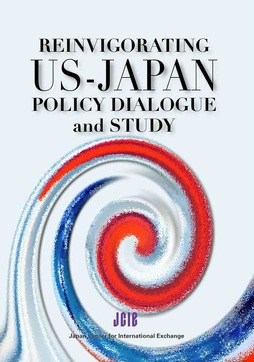 There’s a very JET-relevant report just published by the Japan Center for International Exchange titled “Reinvigorating US-Japan Dialogue and Study.” (Notably, JET alum Jim Gannon (Ehime-ken, 1992-94), Executive Director for the US office of JCIE, was involved in the drafting of the report.)
There’s a very JET-relevant report just published by the Japan Center for International Exchange titled “Reinvigorating US-Japan Dialogue and Study.” (Notably, JET alum Jim Gannon (Ehime-ken, 1992-94), Executive Director for the US office of JCIE, was involved in the drafting of the report.)
Though the report only mentions the JET Program once (on page 33 of the report), it’s clear that the still largely untapped resource that is the JET alumni community of over 50,000 worldwide (25,000+ in the US) has the potential and the ability to play a significant role in US-Japan relations going forward given the decline in energy and resources devoted to US-Japan policy dialogue and study cited in the report.
The gist of the report is that “the institutional base of US-Japan policy dialogue and study has started to erode in recent years.” However, the report also “finds fertile ground to deepen bilateral dialogue and better leverage the extensive human networks that have developed between the two societies.”
The main obstacles to reversing this trend appear to be:
- a shrinking institutional base for US-Japan relations and failure to fully take advantage of available resources (e.g., the JET alum community);
- reduced funds available in Japan to support these activities (due in a large part to a down economy); and
- to some extent, increased interest in and focus on China
As JET alums, the above trends may be beyond our control. But we are a big part of that extensive human network that needs to be leveraged. And regardless of the obstacles, the ball is in our court to be part of the solution. Tough times call for innovative solutions.
Gambarimashou.
Justin’s Japan: Carnegie Hall to Kick Off JapanNYC 2010 Concert Week

- Maestro Seiji Ozawa, artistic director of Carnegie Hall’s JapanNYC festival. (Mark Corke/New York Observer)
By JQ magazine’s Justin Tedaldi (CIR Kobe-shi, 2001-02) for Examiner.com. Visit his NY Japanese Culture page here to subscribe for free alerts on newly published stories.
Starting this Saturday, Carnegie Hall’s JapanNYC festival will unveil its first citywide series of musical performances. Led by artistic director Seiji Ozawa, who is best known for his record-setting 29-year career as music director of the Boston Symphony Orchestra, the festival’s musical highlights next week will see Maestro Ozawa helming rare overseas concerts by the Saito Kinen Orchestra with conductor Tatsuya Shimono, pianist Mitsuko Uchida and others, plus tributes to the legendary late composer Tōru Takemitsu, considered by many to be Japan’s greatest composer.
Additionally, as part of the Works & Process series at the Guggenheim Museum, a series of performances of Prokofiev’s Peter and the Wolf—performed by the Juilliard Ensemble and George Manahan with visual art by Rei Sato of Kaikai Kiki and narration by fashion designer Isaac Mizrahi—will surely delight music fans of all ages.
The performances follow other city exhibitions and ongoing events under the JapanNYC banner that run through next year, including Yoshitomo Nara: Nobody’s Fool at Asia Society, The Sound of One Hand: Paintings and Calligraphy by Zen Master Hakuin at Japan Society, and On Becoming an Artist: Isamu Noguchi and His Contemporaries, 1922-1960 at The Noguchi Museum in Queens.
JapanNYC returns in March and April 2011 with three weeks of events across New York City, including performances of classical, jazz and traditional Japanese music; contemporary theatre and visual art; noh theater and kyogen plays; modern dance; film; taiko drumming and more.
Click here for the complete performance schedule.

